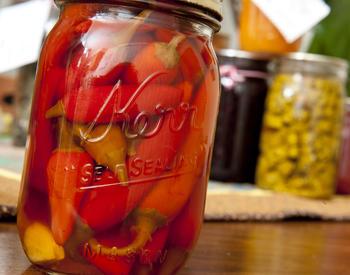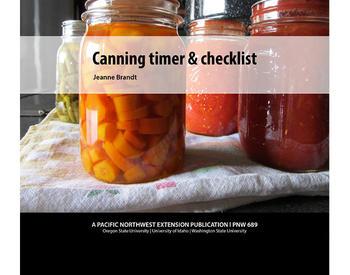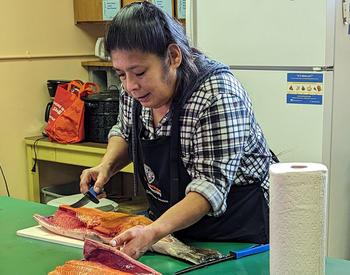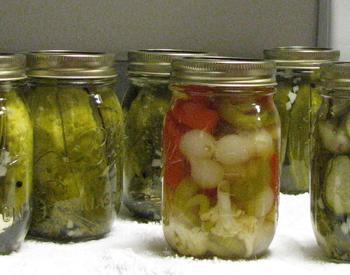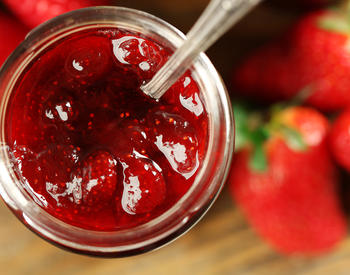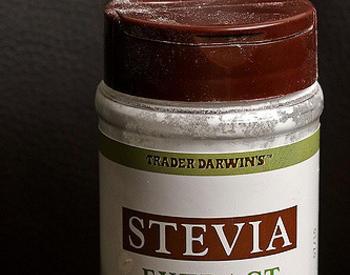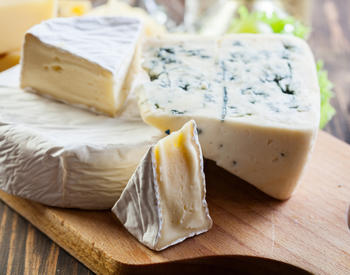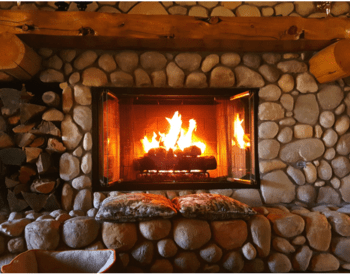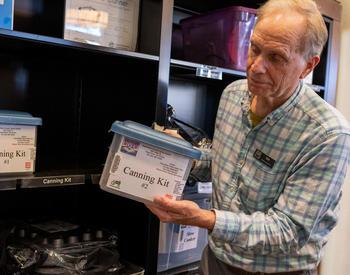Foods that are naturally high in acid, including most fruits, or acidified foods, such as pickles and salsas, may be processed in a steam canner. Most tested recipes for processing high acid foods in a boiling water canner may be adapted for use in a steam canner by using these instructions.
Steam canners process jars in pure steam, so they need less water than boiling water canners. A typical boiling water canner might take 16 quarts of water to fill, while a steam canner only uses about 2 quarts of water. With less water to heat, the steam canner takes less time to come to a boil, so processing is more efficient.
Steam canners come with a shallow bottom, a wire rack, and a domed lid with vent ports. Some models come with a temperature gauge built into the dome. Only the Victorio and Back-to-Basics brand dome- style steam canners have been independently tested. Check with the manufacturers regarding the safety of other brands and models.
Caution: Use care while operating the steam canner as the steam and water can cause serious burn injuries. The highest risk is when opening the steam canner after processing. Tilt the lid away from you when opening it to avoid steam burns.
Note: Steam canners often come with a recipe book with processing instructions. These instructions are not based on current research tested methods and may lead to under processing. Foods processed following the steam canner instructions may not be safe or may spoil.
Tips
- Steam canners use the same research-based processing times and altitude adjustment as boiling water canners. However, they are only safe for foods that are processed 45 minutes or less including any modifications for altitude adjustments. Longer processing times could result in canners running dry and under processing. Use current recipes that have been tested as safe for boiling water canning from the National Center for Home Food Preservation or from your State Extension program or latest edition of the Ball Blue Book.
- Do not open the lid during the timed process.
- You may mix jar sizes during canning. For example, if processing pint and quart jars all jars must be processed for the longest processing time.
- Do not stack jars. The risk of jar breakage from shifting jars is too great.
- The dome lid of most steam canners is tall enough to accommodate quart jars as well as pints, ½ and ¼ pints. The canner rack can be fully loaded or partially loaded with jars.
Directions
- Place rack in bottom of canner, fill with water to the bottom of the rack. Preheat water.
- Jars must be heated prior to filling. Keep hot jars hot, fill only with hot liquid and limit any cooling prior to processing. Follow headspace instructions on the recipes for boiling water canning.
- Load canner with hot, filled jars and place dome lid on canner.
- The steam canner must be vented prior to processing. Turn heat to high and watch for steam from the vent ports. Once a full and steady stream of steam (6 to 8 inches high) is seen coming from the vent, allow for one minute of venting before starting the processing time. Reminder: Be sure to adjust processing time for elevations over 1,000 feet as directed in a research-based recipe for boiling water canning.
- If necessary, adjust the heat throughout the processing time to maintain a steady stream of steam (6 to 8 inches) from the vent ports.
Do not allow the canner to boil too vigorously or it will boil dry, creating an under-processed and potentially unsafe product. Never open the lid during processing to add water.
Do not rely on the temperature gauge on the top of the dome. It can become unreliable.
If the canner does boil dry, the food is under-processed. You must begin again by refilling jars, wiping rims, using new lids, and starting the processing over. - When processing time is completed, remove from heat, and let stand for 5 minutes before removing the lid. When opening, tilt the lid away from you (this will avoid steam burns).
- Use hot pads or a jar lifter to remove jars from canner. Cool jars on a rack or towel at room temperature, allowing air to circulate freely around them. Allow to cool at room temperature 12—24 hours.
Do not retighten screw bands after processing. Retightening hot lids may cut through the softened gasket and cause seal failure. - Check that all jars have sealed, remove bands, and clean outside of jars to remove any food residue.
- Label with the date, contents of the jar, and processing information.
- Store jars in a cool, dark, and dry place. For best quality and nutritive value, use within one year.
Sources: Ingham, B. Guidelines for Using an Atmospheric Steam Canner for Home Food Preservation. University of Wisconsin Extension. 2011, revised 2021.
P. Willmore et al. 2015. Home Processing of Acid Foods in Atmospheric Steam and Boiling Water Canners. Food Protection Trends. 35:150-160.
